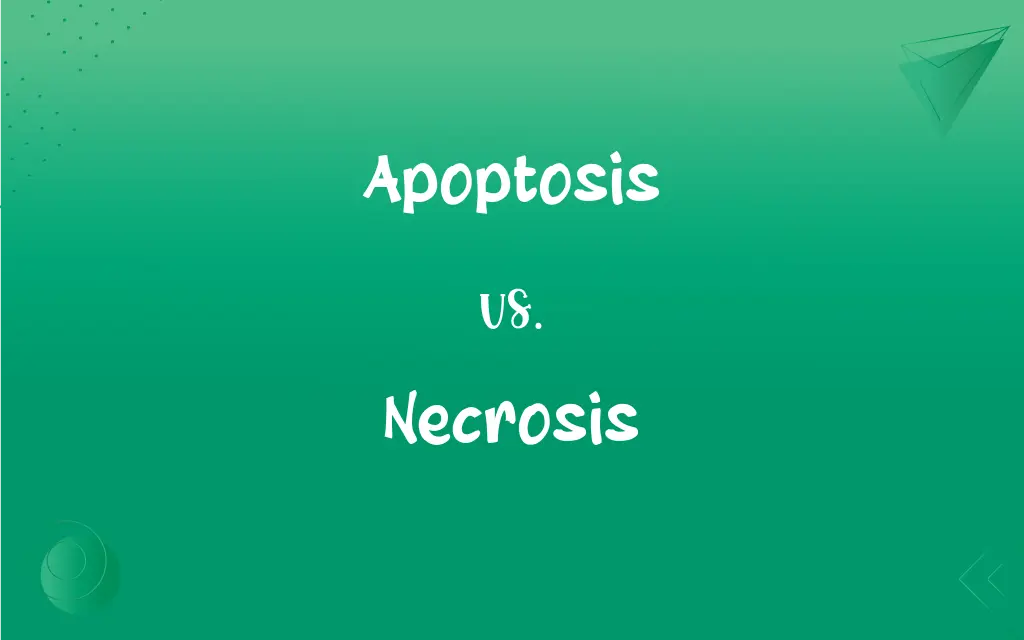Apoptosis vs. Necrosis: What's the Difference?
Edited by Janet White || By Harlon Moss || Updated on October 28, 2023
Apoptosis refers to programmed cell death; Necrosis referts to uncontrolled cell death.

Key Differences
Apoptosis is an orchestrated cellular process resulting in the systematic dismantling of cellular components without provoking inflammation. It's a vital component of various processes including normal cell turnover, proper development and functioning of the immune system, hormone-dependent atrophy, embryonic development, and chemical-induced cell death.
Necrosis, in contrast, often results from acute injury or trauma, leading to the uncontrolled rupture of cell membranes and release of cellular contents. This process often triggers an inflammatory response and can be detrimental to surrounding tissues.
Apoptosis is marked by cellular shrinkage, chromatin condensation, and the formation of apoptotic bodies that are phagocytosed. The integrity of the plasma membrane is preserved during early stages, preventing inflammatory response.
Conversely, necrosis is characterized by swelling of the cell, rupture of the plasma membrane, and subsequent release of intracellular contents into the extracellular space, which can incite inflammation.
In apoptosis, the cellular energy (ATP) is required to drive the process, signifying a controlled and energy-dependent process.
ADVERTISEMENT
Necrosis, however, is typically associated with a loss of cellular energy and is often a result of pathological conditions such as ischemia, toxins, or trauma.
Comparison Chart
Trigger
Controlled, programmed
Uncontrolled, often due to injury
Membrane Integrity
Maintained initially
Compromised, leading to leakage
Inflammatory Response
Generally none
Often present
Cellular Appearance
Shrinkage, fragmentation
Swelling, rupture
ADVERTISEMENT
Energy Requirement
Requires ATP
Associated with energy loss
Apoptosis and Necrosis Definitions
Apoptosis
Controlled cellular dismantling.
Apoptosis maintains tissue homeostasis.
Necrosis
Pathological cell destruction.
Bacterial toxins can induce necrosis in cells.
Apoptosis
Non-inflammatory cell elimination.
Apoptosis occurs without triggering inflammation.
Necrosis
Premature cell death from damage.
Necrosis is often seen in tissues after severe burns.
Apoptosis
Genetically programmed cell death.
Apoptosis is crucial during embryonic development.
Necrosis
Unregulated cell disintegration.
Necrosis resulted from the oxygen deprivation.
Apoptosis
Cell suicide.
Cancer therapy aims to induce apoptosis in malignant cells.
Necrosis
Inflammation-causing cell death.
Necrosis in the liver can cause a severe inflammatory response.
Apoptosis
Cellular self-destruction.
UV radiation can trigger apoptosis in skin cells.
Necrosis
Trauma-induced cell demise.
Physical injury to the muscle led to necrosis.
Apoptosis
A natural process of self-destruction by degradative enzymes in certain cells, such as epithelial cells and erythrocytes, that are genetically programmed to have a limited lifespan or are damaged, as by irradiation or toxic drugs. Also called programmed cell death.
Necrosis
Death of cells through injury or disease, especially in a localized area of a tissue or organ.
FAQs
How is apoptosis different from necrosis in terms of cellular contents?
In apoptosis, cellular contents are contained; in necrosis, they leak out.
Can necrosis lead to inflammation?
Yes, necrosis often triggers an inflammatory response.
What is apoptosis?
Apoptosis is the process of programmed cell death in organisms.
Does apoptosis cause inflammation?
Generally, no. Apoptosis is a non-inflammatory process.
What is necrosis?
Necrosis is uncontrolled cell death typically due to injury or disease.
What are the visible signs of necrosis?
Cell swelling and rupture are common signs of necrosis.
Are apoptotic cells removed from the body?
Yes, they are typically engulfed and removed by phagocytes.
What happens to necrotic tissue?
Necrotic tissue often needs to be removed or can lead to further damage.
Does necrosis occur naturally in the body?
Necrosis usually results from pathological conditions, not natural processes.
What causes necrosis?
Necrosis is often caused by injury, toxins, or lack of oxygen.
Is necrosis always harmful?
Necrosis is generally detrimental, leading to tissue damage.
How does the immune system respond to necrosis?
Necrosis often provokes an immune response due to inflammation.
Can apoptosis be triggered artificially?
Yes, certain therapies aim to induce apoptosis in cancer cells.
Why is apoptosis important?
Apoptosis is essential for normal development and maintaining cellular balance.
How does the immune system respond to apoptosis?
The immune system usually doesn't respond due to the non-inflammatory nature of apoptosis.
Can apoptosis be harmful?
While typically beneficial, excessive apoptosis can lead to diseases.
Can cells recover from necrosis?
Recovery from necrosis is generally not possible due to extensive damage.
Is energy required for apoptosis?
Yes, apoptosis is an energy-dependent process.
Is necrosis an energy-dependent process?
No, necrosis often occurs due to energy loss.
What happens to cells during apoptosis?
During apoptosis, cells shrink and are systematically dismantled.
About Author
Written by
Harlon MossHarlon is a seasoned quality moderator and accomplished content writer for Difference Wiki. An alumnus of the prestigious University of California, he earned his degree in Computer Science. Leveraging his academic background, Harlon brings a meticulous and informed perspective to his work, ensuring content accuracy and excellence.
Edited by
Janet WhiteJanet White has been an esteemed writer and blogger for Difference Wiki. Holding a Master's degree in Science and Medical Journalism from the prestigious Boston University, she has consistently demonstrated her expertise and passion for her field. When she's not immersed in her work, Janet relishes her time exercising, delving into a good book, and cherishing moments with friends and family.































































